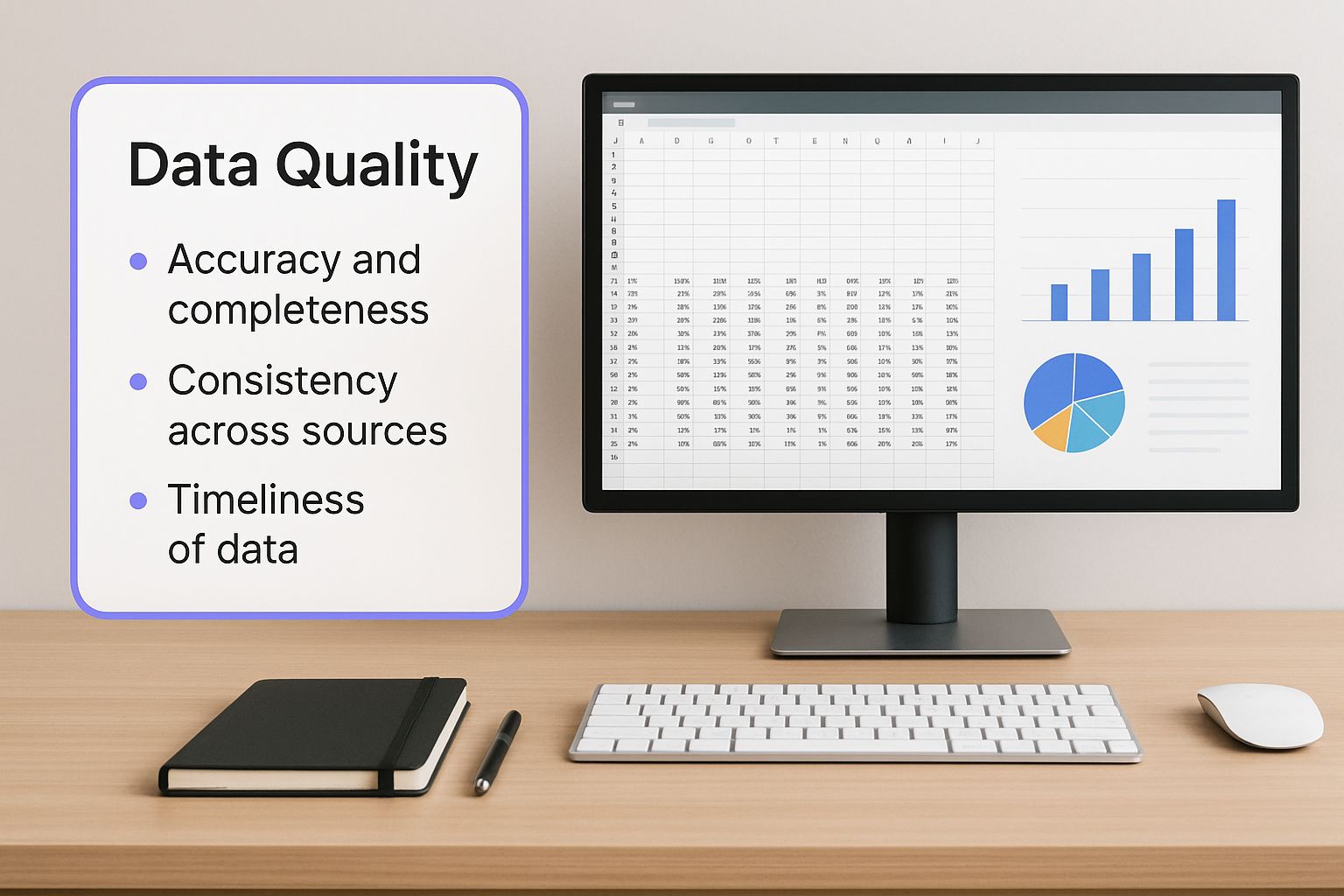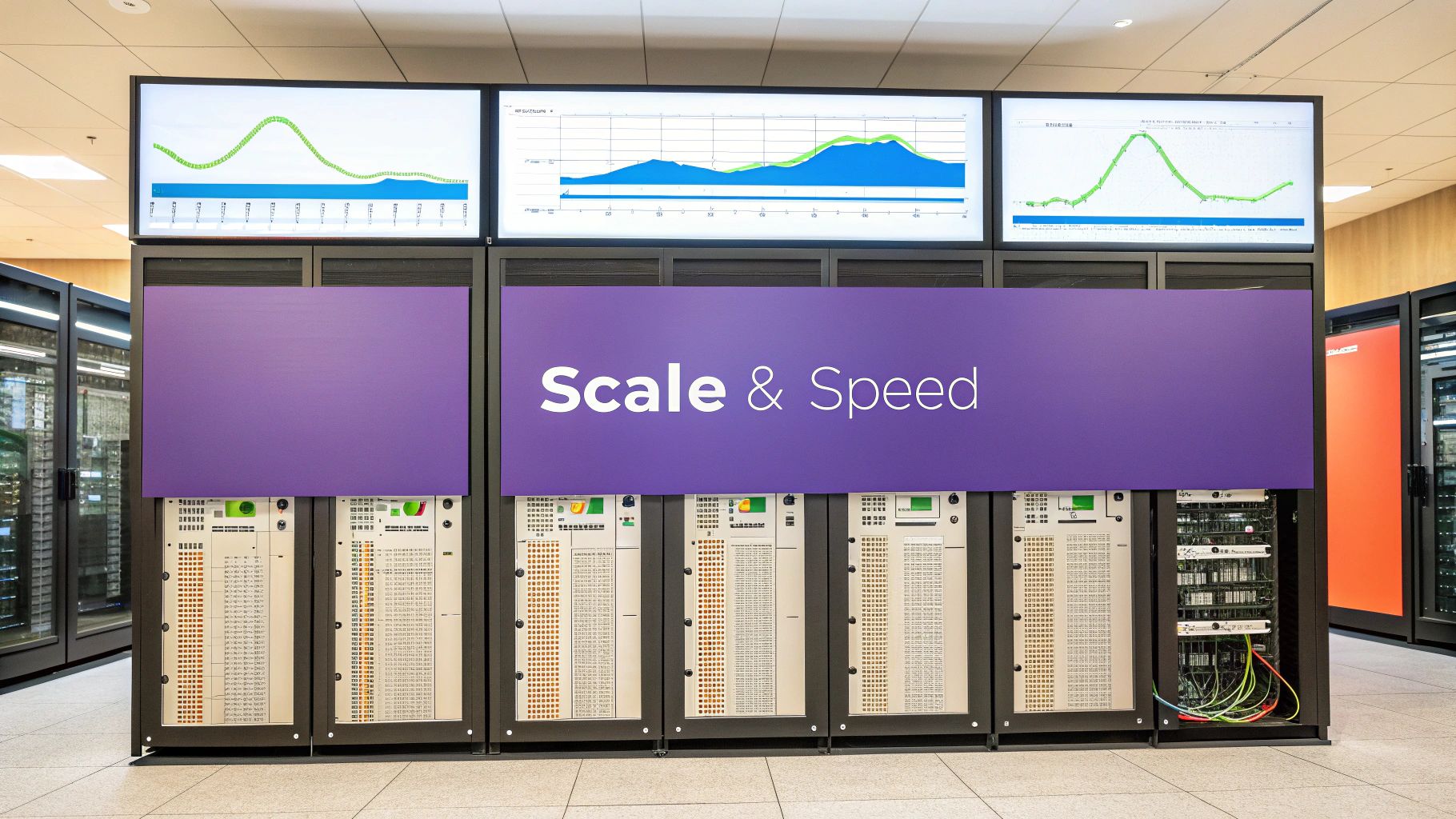
The core problem with data integration today is simple: getting a single, trustworthy view of your business is harder than it’s ever been. Your most valuable information is scattered across a dizzying number of cloud apps, old-school legacy systems, and connected devices, and none of them speak the same language.

Think of it like trying to assemble one giant, coherent puzzle using pieces from a dozen different boxes. The pieces are all different shapes and sizes, the art styles don't match, and you’re pretty sure some are missing entirely. That’s the reality of data integration in a nutshell. We've moved far beyond the simple days of just connecting one database to another.
Modern business runs on a torrent of information. Every single day, organizations around the world create an incredible 328.77 million terabytes of data. This tidal wave of information doesn’t come from one neat source; it flows from an ever-expanding web of systems that are a real headache to manage.
The challenge really starts with the sheer number of places your data now lives. It’s no longer tucked away in a single, tidy database. A typical company's data ecosystem is a chaotic mix of:
This sprawl is what makes data integration so tough. As companies grow and move more operations to the cloud, they often add new layers of complexity. A good cloud migration checklist can help get a handle on the move itself, but it also underscores just how fragmented the end result can be.
Here’s the fundamental conflict. On one side, you have the business screaming for a unified, 360-degree view of everything. Leaders need it for advanced analytics, for building accurate AI models, and for truly understanding the customer journey. All of that requires clean, consolidated, and ready-to-use data.
On the other side, you have the messy reality of your data landscape. Each system has its own format, its own rules, and its own structure. This creates invisible walls—data silos—that stop information from moving where it needs to go.
This isn’t just an IT problem; it’s a major business roadblock. Solving these integration challenges is non-negotiable for any company that wants to compete. It's the essential groundwork you have to lay before you can unlock the real value of your data. If you don't, your AI projects will stall, your analytics will be misleading, and your decisions will be based on a dangerously incomplete picture.
Getting your data to work together is the foundation of any smart business strategy, but the path is rarely smooth. These hurdles aren't just small technical headaches; they're major roadblocks that can completely derail your plans, poison your analytics, and ultimately stop growth in its tracks. The first step to fixing these problems is knowing exactly what you're up against.
Let’s dive into the five biggest data integration challenges that businesses run into time and time again.
Picture this: your sales team uses Salesforce, your marketing team lives in HubSpot, and customer support relies on Zendesk. Each department has a piece of the customer story, but no one has the full picture. This is the classic data silo problem—your most valuable information is trapped on separate islands.
When data is fragmented like this, you get a disjointed and incomplete view of your own business. It becomes impossible to see how a marketing campaign actually drove sales or how a support ticket impacted customer loyalty. Without that unified view, you're essentially making decisions with one eye closed, unable to connect the dots that reveal true, actionable insights.
Even if you successfully pull all your data into one place, it’s worthless if it’s wrong. Poor data quality is one of the most stubborn challenges out there, and it can quickly turn promising insights into dangerous misinformation.
This "dirty data" problem shows up in a few common ways:
This is a critical point. Without clean, reliable data, even the most advanced tools will spit out junk.

As you can see, making decisions based on bad data is often far worse than having no data at all. It gives you a false sense of confidence while leading you in the wrong direction.
As your business grows, so does your data. A lot. The integration methods that worked perfectly when you were a small startup can quickly grind to a halt under the weight of enterprise-level data volume. Many traditional integration tools simply can't keep up with the sheer scale and speed of modern data, from millions of daily user clicks to endless streams of IoT sensor data.
When your integration pipeline can't handle the load, you get slow data processing, delayed reports, and frustrated teams waiting for information. This performance lag means your business is constantly running on old news, putting you at a huge disadvantage in a market that moves faster every day.
In today's world, waiting for nightly data updates is often too little, too late. Businesses need information the moment it happens. Your marketing team needs to act the instant a hot lead shows interest, and your logistics manager needs to track shipments in real-time, not see where they were six hours ago.
The core challenge is that most legacy systems were never designed for this. They were built for batch processing and nightly reports, not the constant, live flow of information that drives modern business. Meeting this demand for speed requires a completely new way of thinking about integration architecture.
Finally, pulling data from multiple sources into a central location creates a tempting target for cyberattacks. Every connection point in your integration pipeline is a potential vulnerability, and consolidating all your sensitive customer and financial data makes you a high-value prize.
Securing this information is a massive undertaking, especially with robust cloud data loss prevention strategies now being a necessity, not a luxury. On top of that, you have to navigate a maze of strict regulations like GDPR and CCPA that govern how you handle personal data. A single data breach or compliance slip-up can lead to crippling fines, legal battles, and permanent damage to your brand's reputation.
To put it all together, here's a quick look at these common hurdles and the real-world pain they cause.
As you can see, these aren't just technical issues for the IT department to solve. They are fundamental business problems that directly affect your ability to compete and thrive.

One of the most stubborn and costly hurdles in data integration is the data silo. Picture them as invisible walls between your company’s departments. Marketing has its data, sales has its own, and customer support operates from yet another island. Each team’s island is functional on its own, but no one has a map of the entire ocean.
Silos aren't built on purpose. They spring up organically as a business scales. The marketing team adopts a killer platform for running campaigns, while finance settles on a specialized tool for billing. Before you know it, crucial business information is locked away in systems that were never meant to talk to each other. Mergers and acquisitions just throw fuel on the fire, piling new, incompatible systems on top of the old ones.
This fragmentation is far more than a technical headache; it’s a strategic bottleneck. When data is scattered, it creates a distorted, incomplete picture of your business, directly undermining your most important goals.
When your data lives in separate, disconnected buckets, you pay a heavy price. The much-coveted 360-degree customer view becomes a pipe dream. How can you map the entire customer journey if you can't connect the dots between the initial marketing email, the final sale, and the support ticket six months later?
The fallout from this disconnect is serious:
This isn’t a niche problem—it's a massive challenge across industries. In fact, a recent survey revealed that 68% of data professionals named data silos as their biggest concern, a figure that climbed by 7% from the previous year. This shows that even with all the new technology at our disposal, unifying data remains a struggle, blocking companies from gaining true enterprise-wide insights. You can dig deeper into this and other related topics by exploring the latest data strategy trends.
Breaking down data silos isn't about a single quick fix. It takes a thoughtful strategy that blends technology, process, and culture. The goal isn't to force every team onto one giant, cumbersome platform. It’s about building bridges between the systems they already know and love.
The point isn't to get rid of specialized tools. It's to make the data inside them accessible and interoperable. Real integration lets information flow freely, creating a single source of truth without blowing up existing workflows.
Here are a few practical ways to start dismantling those walls:
Once you’ve pinpointed the data integration hurdles holding your business back, the next question is obvious: How do we fix them? Choosing the right integration strategy isn’t about finding a single "best" method. It's more like building a custom toolkit, where you select the right tool for the right job based on your specific goals, data, and business needs.
This decision is critical. It directly determines how well you can break down data silos and meet the ever-growing demand for real-time information. Let’s walk through the core strategies that form the backbone of modern data integration, using some simple analogies to see where each one truly shines.
The most established and well-known method is ETL (Extract, Transform, Load). Think of a master chef who meticulously preps every single ingredient before it even gets close to the main cooking station. The chef (your ETL process) goes to different markets (your source systems), washes and chops everything (transforms the data), and then arranges it all perfectly on a platter, ready for use (loads it into the destination).
ETL is the gold standard when you need highly structured, pristine data for business intelligence and formal reporting. It's the classic approach for building traditional data warehouses where data quality and consistency are non-negotiable. The downside? Its pre-defined transformation process can be rigid, and it typically runs in batches (like nightly updates), which means it's not the fastest.
On the other hand, ELT (Extract, Load, Transform) completely flips the script. This is like bringing all your groceries home and tossing them straight into a big, powerful pantry (your cloud data lake or warehouse). You decide what you want to make and how to prep the ingredients after they're already in your kitchen.
This approach is all about speed and flexibility. By loading raw data directly into the destination, ELT takes advantage of the massive processing power of modern cloud platforms like Snowflake, Google BigQuery, or Amazon Redshift to handle transformations on the fly.
With the explosion of cloud computing, this method has become incredibly popular. It’s perfect for handling huge volumes of both structured and unstructured data, giving data scientists the freedom to experiment with raw information without being boxed in by a predefined schema. This gives you the agility to adapt to new analytics questions as soon as they come up.
Both ETL and ELT often work in batches, but that’s just not fast enough for many of today's business needs. This is where real-time data streaming, often driven by Change Data Capture (CDC), enters the picture. Think of it as a live news feed that reports events the instant they happen, instead of giving you a summary at the end of the day.
CDC works by constantly monitoring your source databases for changes—a new sale is logged, a customer updates their address, inventory levels drop—and immediately streams that single event to the target systems. This is what makes true, real-time analytics and operations possible.
This approach is essential for:
Here’s the thing: no matter which strategy you pick—ETL, ELT, or real-time streaming—none of it will work without a solid foundation of data governance. Governance is the official rulebook for your data. It defines what your data actually means, who is allowed to use it, and how it must be managed to stay accurate, consistent, and secure.
Without good governance, your newly integrated data can become just as messy and unreliable as it was when it was stuck in silos. It’s the critical piece that ensures the final output of your integration work is actually valuable. To navigate these choices effectively, it helps to review established data integration best practices that highlight the importance of a strong governance framework.
Ultimately, your choice of strategy is a pivotal step. The right mix of methods, all supported by smart governance, is what turns data from a fragmented liability into a powerful, unified asset that drives smarter business decisions.
Let's be honest: the old ways of handling data integration just don't cut it anymore. Manual coding and rigid, old-school ETL pipelines are slow, brittle, and demand way too much hands-on effort to meet today's business needs. A new generation of intelligent platforms, like Statisfy, is stepping in and completely rewriting the rules for how organizations connect their data.
Instead of throwing teams of engineers at the problem to manually code every single connection, these platforms use artificial intelligence to automate the most frustrating and error-prone parts of the job. It’s like ditching a hand-drawn map for a live, self-updating GPS. The AI doesn’t just show you the path—it sees traffic ahead, finds detours around accidents, and gets smarter about the best routes over time.
This isn't just a fleeting trend; it's a direct response to a real market need. The global data integration market is set to expand at a 13.8% compound annual growth rate, largely because everyone is moving to the cloud and demanding real-time analytics. As more companies adopt an integration-first mindset—especially in sectors like finance that are desperate for a complete customer picture—smarter tools become a necessity, not a luxury. You can get a deeper look into these market shifts and understand why data integration is a growing priority.
Ask any data engineer about their least favorite task, and schema mapping will probably be at the top of the list. It’s the soul-crushing process of telling a system that the customer_id field in one database is the same as the client_identifier field in another. When you're dealing with dozens of sources and thousands of fields, this turns into a massive, mind-numbing headache.
AI-powered platforms go straight for this bottleneck. They can scan the schemas from all your different sources and automatically suggest mappings with a surprisingly high degree of accuracy. The system learns from past integrations and common data patterns to make smart recommendations, effectively turning what used to be weeks of tedious work into a few hours of quick review and confirmation.
Beyond that, the AI can also intelligently propose data transformations. For instance, it might notice one system stores a full name in a single field ("John Doe") while another splits it into first_name and last_name. The platform can then automatically suggest the logic needed to standardize the data, saving your team from writing yet another custom script.
For too long, data integration has operated on a "fail and fix" model. Bad data gets dumped into the warehouse, messes up a critical report, and only then does someone scramble to figure out what went wrong. This reactive cycle kills trust in your data and leads to some truly flawed business decisions.
Intelligent platforms flip the script by embedding quality checks right into the data pipeline.
AI algorithms monitor data streams in real time, automatically flagging anomalies and inconsistencies before they ever contaminate your analytics environment. Think of it as having a quality control inspector on your digital assembly line, catching defects the moment they appear.
These platforms learn what "normal" data looks like for your business, allowing them to spot deviations a human would almost certainly miss, such as:
By catching these problems early, the AI ensures the data fueling your decisions is consistently clean and trustworthy.
Finally, one of the biggest wins with AI-powered integration is its ability to scale without breaking a sweat. Traditional tools often need significant, costly re-engineering to handle more data or connect to new sources. In contrast, modern platforms are built on flexible, cloud-native architectures that can dynamically adjust as your business grows.
This agility means your data infrastructure stops being a bottleneck. Whether you’re bringing a new fleet of IoT sensors online or integrating data from a company you just acquired, an intelligent platform can adapt on the fly. You aren't stuck planning a massive, disruptive overhaul. This makes it a much more resilient and future-proof solution for handling the data integration challenges that are simply a part of doing business today.
It’s completely normal. Diving into data integration often feels like opening a can of worms—the more you learn, the more questions you have. It's one thing to grasp the concepts, but another to figure out how they apply to your business.
Let's clear up a few of the most common questions we hear from people just like you. My aim here is to give you straightforward answers that cut through the noise and help you feel confident about taking the next step.
If I had to pick just one, it’s data quality. Hands down. It's the silent killer of so many promising analytics and AI initiatives. You can have the slickest tools and a brilliant strategy, but if the data you're pulling in is a mess of inaccuracies, inconsistencies, and gaps, the whole project is built on a foundation of sand.
This isn't just a technical headache; it’s a massive business risk. When your leadership team can't trust the numbers in their dashboards, every decision becomes a gamble. From analyzing customer churn to forecasting revenue, everything gets skewed. Poor data quality erodes trust, and without trust, your data is worthless.
Think of it like this: trying to integrate bad data is like meticulously building a high-performance engine using rusty, mismatched parts. No matter how well you assemble it, it’s never going to run properly and will inevitably break down.
This is a critical decision, and the key is to avoid getting dazzled by flashy features. The "best" tool isn't a one-size-fits-all solution; it's the one that fits your specific reality. Picking the wrong one can lock you into a system that causes more headaches than it solves.
To get it right, start by asking yourself a few honest questions:
For businesses that need to be agile and responsive, modern AI-powered platforms are often the answer. They're built for complex, ever-changing environments where real-time data is a must. On the other hand, if your needs are simpler—say, for basic data warehousing with batch updates—a traditional ETL tool might be all you need.
It’s easy to get these two mixed up because they’re so closely related, but the distinction is important.
Data integration is the big-picture strategy. It’s the overall discipline of bringing data together from all your different systems to create a single, reliable source of truth. It's the "what" and the "why" of the entire effort.
ETL (Extract, Transform, Load) is just one specific method for getting that job done. It's a popular and long-standing technique, but it's just one tool in the toolbox. It's the "how."
Here’s a simple way to think about it:
But lasagna isn't the only meal you can make. You could also grill (ELT) or toss a fresh salad (real-time streaming). These are all different methods (recipes) to achieve the same goal (a complete meal). Data integration is the whole cookbook; ETL is just one recipe in it.
Ready to stop wrestling with your data and finally get that unified view of your customers? The Statisfy AI-driven platform handles the most frustrating parts of integration, from automatically mapping schemas to validating data quality as it flows. It's time to build better customer relationships, not another data pipeline.
Discover how Statisfy can transform your customer data strategy today.